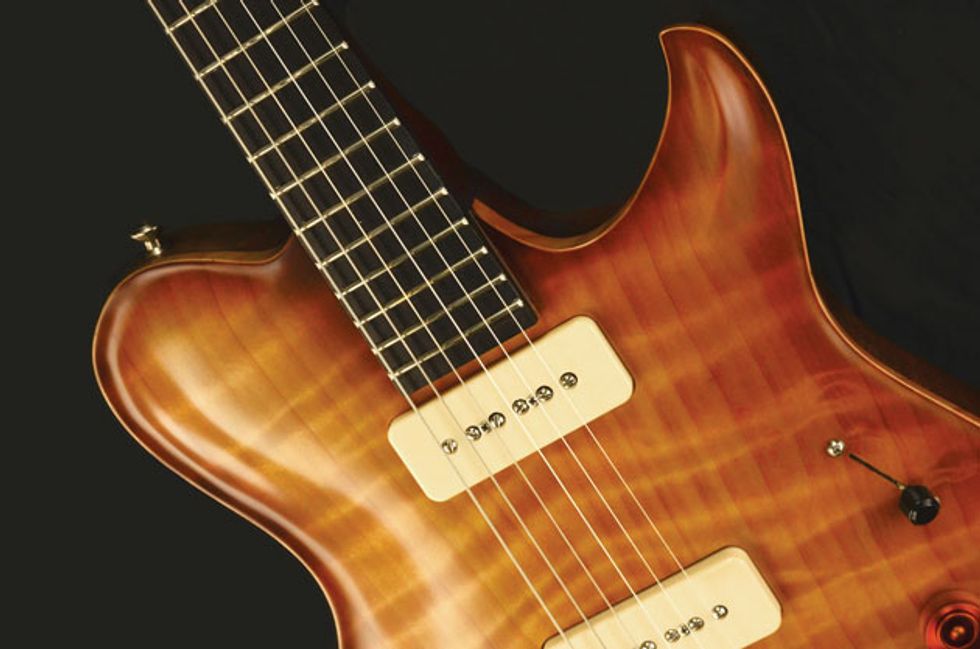A quick scan of any guitar-related periodical or website will reveal plentiful use of the words archtop and carved top to describe guitars’ features. A few builders have even included this description in the actual model names of their guitars. As consumers and observers of guitar gear, we’ve all come to know and accept this description as meaning a relief design in which the center of a guitar’s face is raised slightly above the rim. And although the terms are often used interchangeably, they are not necessarily the same or even achieved in the same way. So what does an arched (or carved) guitar top do besides look pretty cool?
Part of the answer lies in the origins of the arched musical-instrument top. The best-known instrument in the arched-top family is certainly the violin, along with its cousins the viola, violoncello, and the redheaded stepchild known as the string bass. These familiar acoustic instruments all feature arched tops and backs. Their basic layout uses a tall bridge and steep neck pitch to exert downward pressure on the top, which increases the transfer of vibration to the plate (top) and body. Ancient makers of these instruments found that they could reduce the thickness and mass of the top to improve volume, and that the downward pressure was limited by the top’s strength. The solution was to employ an architectural element known as a dome, which is really a series of arches.
Sports and concert fans are familiar with this building technique. It’s used to create huge, open-space arenas that forego vertical columns to support their roofs, allowing clear sightlines to the bludgeoning. The weight pressing straight down is diverted along the curved shape to the footings (or the sides, in the case of a guitar). This allows a dome to support its own weight and beyond, and makes it easy to see how a hollow, acoustic instrument can benefit from a domed top. Such was the case at Gibson—primarily a mandolin manufacturer in the early part of the 20th century—whose violin-inspired, Lloyd Loar-designed instruments were considered to be the very best.
When Loar was asked to create a guitar design for Gibson in 1922, he naturally carried the practice of the arch over to the new L-5—a stark contrast to the flattop offerings from competitors Washburn and Martin. In the case of a larger instrument like a guitar, the arched shape allowed the builder to reduce the size and weight of any internal beams (aka braces), further enhancing the top’s ability to respond to bridge vibration.
But possibly the best part was that the gently carved top gave the guitar a spectacular, classical image that aligned it with “serious” musical instruments like those in the violin family. Obviously, Gibson was onto something. The L-5 has remained in production in one form or another ever since.
Still, the carved, arched top presented a problem for builders. An arched guitar is costly to make because the top is carved from a thick piece of spruce, whereas a flattop can be machine cut with little waste. Builders have always sought to streamline this process: first with mechanical duplicating carvers that followed a physical template, and today with computer-guided machines. By the post-war period, many manufacturers had mechanized the carving process, but Gibson once again showed the way forward by championing the practice of pressed-arch laminated tops, beginning with the ES-175 model in 1949. The use of laminated hardwood kept costs down, and pressing the arch into flat sheets with hydraulic machinery reduced the amount of time needed for building the domed guitars.
When Gibson entered the solid-body market in 1952, their Les Paul model guitar mirrored the arched look of their hollow guitars, no doubt for marketing reasons. The Les Paul was a response to Fender’s plain-Jane Telecaster … the boys in Kalamazoo wanted to show those Californians how it was done. True enough, a few years after that, Fender did add some contour sanding (mainly for comfort) to their new Stratocaster model. And although it serves no structural purpose, the practice of “carving” a solidbody electric’s top remains a mainstay of guitar fashion.
Today, very few guitars of any kind have arched tops that are truly handcarved in the old-school, violin-maker way. It’s a beautiful process to watch, but is usually reserved for high-dollar jazz guitars. There are some who claim that solid, carved tops have the best sound, while others cite pressed-laminate guitars as being more spunky sounding and feedback resistant. Personally, I don’t think it’s as simple as that. Generalizations are Internet fodder and I only mention these sorts of observations to incite your wrath and drive traffic to my story.
But seriously, the difference between arched, carved, and pressed tops for guitars should be clear to you now, even if not to the folks writing advertising copy.







![Rig Rundown: Russian Circles’ Mike Sullivan [2025]](https://www.premierguitar.com/media-library/youtube.jpg?id=62303631&width=1245&height=700&quality=70&coordinates=0%2C0%2C0%2C0)

























